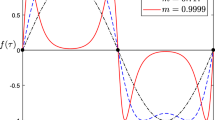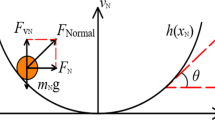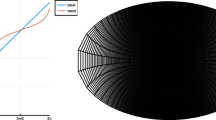Abstract
Two novel methods to determine detached periodic solution branches of low-dimensional and large-scale friction-damped mechanical systems have been developed. The approach for low-dimensional systems is an extension of the global terrain method and consists of three steps: First, the non-smooth elastic Coulomb slider is temporarily modified to pose a \(C^2\) continuous energy surface in the frequency domain. Second, the global terrain method is extended to rescale the search space consecutively along multiple eigendirections of the Hessian at the solution points, facilitating the determination of disconnected solutions. Finally, found solutions are used as the starting points for a homotopy strategy to detect the solutions of the original non-smooth problem. The method for large-scale systems based on an invariant manifold approach consists of three steps: First, the system’s dimension is decreased following a nonlinear modal reduction leading to a two-dimensional surrogate problem. Second, various subspaces for direct extrema, direct bifurcation, constant frequency, and constant amplitude solution detection are defined. Finally, a deterministic line search, a stochastic global solution method, and a newly developed deterministic line deflation are applied to the problem. The proposed methods are applied to low-dimensional and large-scale friction-damped mechanical systems simultaneously subjected to external and self-excitation as well as a low-dimensional mechanical system with shape-memory alloy nonlinearity subjected to external excitation. Their ability to find all solutions is discussed and compared with existing solution procedures such as bifurcation tracking, deflation, homotopy, and the global terrain method. Depending on the chosen subspace for the global search, the proposed methods are capable of providing additional detached solution branches (isola).











































Similar content being viewed by others
References
Iwan, W.D.: Steady-state dynamic response of a limited slip system. J. Appl. Mech. 35(2), 322–326 (1968)
Iwan, W.D., Furuike, D.M.: The transient and steady-state response of a hereditary system. J. Non-Linear Mech. 8(4), 395–406 (1973)
Capecchi, D., Vestroni, F.: Periodic response of a class of hysteretic oscillators. Int. J. Non-Linear Mech. 25(2–3), 309–317 (1990)
Hayashi, C.: The influence of hysteresis on nonlinear resonance. J. Frankl. Inst. 281(5), 379–386 (1966). https://doi.org/10.1016/0016-0032(66)90299-7
Salles, L., Staples, B., Hoffmann, N., Schwingshackl, C.: Continuation techniques for analysis of whole aeroengine dynamics with imperfect bifurcations and isolated solutions. Nonlinear Dyn. 86(3), 1897–1911 (2016). https://doi.org/10.1007/s11071-016-3003-y
Perret-Liaudet, J., Rigaud, E.: Superharmonic resonance of order 2 for an impacting Hertzian contact oscillator: theory and experiments. J. Comput. Nonlinear Dyn. 2(2), 190 (2007). https://doi.org/10.1115/1.2447549
Bureau, E., Schilder, F., Elmegård, M., Santos, I.F., Thomsen, J.J., Starke, J.: Experimental bifurcation analysis of an impact oscillator—determining stability. J. Sound Vib. 333(21), 5464–5474 (2014). https://doi.org/10.1016/j.jsv.2014.05.032
Elmegård, M., Krauskopf, B., Osinga, H.M., Starke, J., Thomsen, J.J.: Bifurcation analysis of a smoothed model of a forced impacting beam and comparison with an experiment. Nonlinear Dyn. 77(3), 951–966 (2014). https://doi.org/10.1007/s11071-014-1353-x
Takács, D., Stépán, G., Hogan, S.J.: Isolated large amplitude periodic motions of towed rigid wheels. Nonlinear Dyn. 52(1–2), 27–34 (2008). https://doi.org/10.1007/s11071-007-9253-y
Doole, S.H., Hogan, S.J.: A piece wise linear suspension bridge model: nonlinear dynamics and orbit continuation. Dyn. Stab. Syst. 11(1), 19–47 (1996). https://doi.org/10.1080/02681119608806215
Rega, G.: Nonlinear vibrations of suspended cables—part ii: deterministic phenomena. Appl. Mech. Rev. 57(6), 479–514 (2004)
Lenci, S., Ruzziconi, L.: Nonlinear phenomena in the single-mode dynamics of a cable-supported beam. Int. J. Bifurc. Chaos 19(3), 923–945 (2009). https://doi.org/10.1142/S021812740902338X
Duan, C., Rook, T.E., Singh, R.: Sub-harmonic resonance in a nearly pre-loaded mechanical oscillator. Nonlinear Dyn. 50(3), 639–650 (2007). https://doi.org/10.1007/s11071-006-9185-y
Duan, C., Singh, R.: Isolated sub-harmonic resonance branch in the frequency response of an oscillator with slight asymmetry in the clearance. J. Sound Vib. 314(1–2), 12–18 (2008). https://doi.org/10.1016/j.jsv.2007.12.040
von Wagner, U., Lentz, L.: On artifact solutions of semi-analytic methods in nonlinear dynamics. Arch. Appl. Mech. 88(10), 1713–1724 (2018). https://doi.org/10.1007/s00419-018-1397-3
Nayfeh, A.H., Mook, D.T.: Nonlinear Oscillations, Wiley Classics Library Edition. Wiley, New York (1995)
Lee, S.I., Howell, S.W., Raman, A., Reifenberger, R.: Nonlinear dynamic perspectives on dynamic force microscopy. Ultramicroscopy 97(1–4), 185–198 (2003). https://doi.org/10.1016/S0304-3991(03)00043-3
Misra, S., Dankowicz, H., Paul, M.R.: Degenerate discontinuity-induced bifurcations in tapping-mode atomic-force microscopy. Physica D 239(1–2), 33–43 (2010). https://doi.org/10.1016/j.physd.2009.10.001
Koenigsberg, W.D., Dunn, J.C.: Jump resonant frequency islands in nonlinear feedback control systems. IEEE Trans. Autom. Control 20(2), 208–217 (1975). https://doi.org/10.1109/TAC.1975.1100914
Fukuma, A., Matsubara, M.: Jump resonance in nonlinear feedback systems—part i: approximate analysis by the describing-function method. IEEE Trans. Autom. Control 23(5), 891–896 (1978)
Hirai, K., Sawai, N.: A general criterion for jump resonance of nonlinear control systems. IEEE Trans. Autom. Control 23(5), 896–901 (1978)
Gourdon, E., Alexander, N.A., Taylor, C.A., Lamarque, C.H., Pernot, S.: Nonlinear energy pumping under transient forcing with strongly nonlinear coupling: theoretical and experimental results. J. Sound Vib. 300(3–5), 522–551 (2007). https://doi.org/10.1016/j.jsv.2006.06.074
Starosvetsky, Y., Gendelman, O.V.: Vibration absorption in systems with a nonlinear energy sink: nonlinear damping. J. Sound Vib. 324(3–5), 916–939 (2009). https://doi.org/10.1016/j.jsv.2009.02.052
Gourc, E., Michon, G., Seguy, S., Berlioz, A.: Experimental investigation and design optimization of targeted energy transfer under periodic forcing. J. Vib. Acoust. 136(2), 021021 (2014)
Gatti, G.: Uncovering inner detached resonance curves in coupled oscillators with nonlinearity. J. Sound Vib. 372, 239–254 (2016). https://doi.org/10.1016/j.jsv.2016.02.027
Alexander, N.A., Schilder, F.: Exploring the performance of a nonlinear tuned mass damper. J. Sound Vib. 319(1–2), 445–462 (2009). https://doi.org/10.1016/j.jsv.2008.05.018
Habib, G., Detroux, T., Viguié, R., Kerschen, G.: Nonlinear generalization of Den Hartog’s equal-peak method. Mech. Syst. Signal Process. 52–53, 17–28 (2015). https://doi.org/10.1016/j.ymssp.2014.08.009
Habib, G., Kerschen, G.: A principle of similarity for nonlinear vibration absorbers. Physica D 332, 1–8 (2016). https://doi.org/10.1016/j.physd.2016.06.001
Cirillo, G.I., Habib, G., Kerschen, G., Sepulchre, R.: Analysis and design of nonlinear resonances via singularity theory. J. Sound Vib. 392, 295–306 (2017). https://doi.org/10.1016/j.jsv.2016.12.044
Kuether, R.J., Renson, L., Detroux, T., Grappasonni, C., Kerschen, G., Allen, M.S.: Nonlinear normal modes, modal interactions and isolated resonance curves. J. Sound Vib. 351, 299–310 (2015). https://doi.org/10.1016/j.jsv.2015.04.035
Noël, J.P., Detroux, T., Masset, L., Kerschen, G., Virgin, L.N.: Isolated response curves in a base-excited, two-degree-of-freedom, nonlinear system. In: ASME 2015 International Design Engineering Technical Conferences and Computers and Information in Engineering Conference, p. V006T10A043 (2015) https://doi.org/10.1115/DETC2015-46106
Arroyo, S.I., Zanette, D.H.: Duffing revisited: phase-shift control and internal resonance in self-sustained oscillators. Eur. Phys. J. B 89(1), 237 (2016). https://doi.org/10.1140/epjb/e2015-60517-3
Detroux, T., Noël, J.P., Kerschen, G., Virgin, L.N.: Experimental study of isolated response curves in a two-degree-of-freedom nonlinear system. Nonlinear Dyn., vol. 1, pp. 229–235. Springer, Cham (2016)
Hill, T.L., Neild, S.A., Cammarano, A.: An analytical approach for detecting isolated periodic solution branches in weakly nonlinear structures. J. Sound Vib. 379, 150–165 (2016). https://doi.org/10.1016/j.jsv.2016.05.030
Mangussi, F., Zanette, D.H.: Internal resonance in a vibrating beam: a zoo of nonlinear resonance peaks. PLoS ONE 11(9), e0162365 (2016). https://doi.org/10.1371/journal.pone.0162365
Shaw, A.D., Hill, T.L., Neild, S.A., Friswell, M.I.: Periodic responses of a structure with 3:1 internal resonance. Mech. Syst. Signal Process. 81, 19–34 (2016). https://doi.org/10.1016/j.ymssp.2016.03.008
DiBerardino, L.A., Dankowicz, H.: Accounting for nonlinearities in open-loop protocols for symmetry fault compensation. J. Comput. Nonlinear Dyn. 9(2), 021002 (2014)
Habib, G., Cirillo, G.I., Kerschen, G.: Uncovering detached resonance curves in single-degree-of-freedom systems. Procedia Eng. 199, 649–656 (2017). https://doi.org/10.1016/j.proeng.2017.09.116
Habib, G., Cirillo, G.I., Kerschen, G.: Isolated resonances and nonlinear damping. Nonlinear Dyn. 93(3), 979–994 (2018). https://doi.org/10.1007/s11071-018-4240-z
Kappauf, J., Hetzler, H.: Bifurcations and limit cycles due to self-excitation in nonlinear systems with joint friction: phenomena and approximation schemes. Proc. ISMA 2018, 3343–3352 (2018)
Detroux, T., Renson, L., Masset, L., Kerschen, G.: The harmonic balance method for bifurcation analysis of large-scale nonlinear mechanical systems. Comput. Methods Appl. Mech. Eng. 296, 18–38 (2015). https://doi.org/10.1016/j.cma.2015.07.017
Renson, L., Barton, D.A.W., Neild, S.A.: Experimental tracking of limit-point bifurcations and backbone curves using control-based continuation. Int. J. Bifurc. Chaos 27(01), 1730002 (2017). https://doi.org/10.1142/S0218127417300026
Brown, K.M., Gearhart, W.B.: Deflation techniques for the calculation of further solutions of a nonlinear system. Numer. Math. 16(4), 1–3 (1971). https://doi.org/10.1016/B978-0-08-009670-4.50006-9
Eaves, B.Curtis (ed.): Homotopy Methods and Global Convergence, vol. 13. Springer, New York (1983)
Ojika, T.: Modified deflation algorithm for the solution of singular problems. I. A system of nonlinear algebraic equations. J. Math. Anal. Appl. 123(1), 199–221 (1987). https://doi.org/10.1007/978-1-349-18669-3_1
Farrell, P.E., Birkisson, Á., Funke, S.W.: Deflation techniques for finding distinct solutions of nonlinear partial differential equations. SIAM J. Sci. Comput. 37(4), A2026–A2045 (2015). https://doi.org/10.1137/140984798
Kuno, M., Seader, J.D.: Computing all real solutions to systems of nonlinear equations with a global fixed-point homotopy. Ind. Eng. Chem. Res. 27(7), 1320–1329 (1988). https://doi.org/10.1021/ie00079a037
Gritton, K.S., Seader, J.D., Lin, W.J.: Global homotopy continuation procedures for seeking all roots of a nonlinear equation. Comput. Chem. Eng. 25(7–8), 1003–1019 (2001). https://doi.org/10.1016/S0098-1354(01)00675-5
Lee, J., Chiang, H.D.: Convergent regions of the Newton homotopy method for nonlinear systems: theory and computational applications. IEEE Trans. Circuits Syst. I: Fundam. Theory Appl. 48(1), 51–66 (2001)
Allgower, E.L., Georg, K.: Introduction to Numerical Continuation Methods, Classics in Applied Mathematics. SIAM, Philadelphia, PA (2003)
Malinen, I., Tanskanen, J.: Modified bounded homotopies to enable a narrow bounding zone. Chem. Eng. Sci. 63(13), 3419–3430 (2008). https://doi.org/10.1016/j.ces.2008.04.006
Malinen, I., Tanskanen, J.: Homotopy parameter bounding in increasing the robustness of homotopy continuation methods in multiplicity studies. Comput. Chem. Eng. 34(11), 1761–1774 (2010). https://doi.org/10.1016/j.compchemeng.2010.03.013
Malinen, I., Kangas, J., Tanskanen, J.: A new newton homotopy based method for the robust determination of all the stationary points of the tangent plane distance function. Chem. Eng. Sci. 84, 266–275 (2012). https://doi.org/10.1016/j.ces.2012.08.037
Pan, B., Lu, P., Pan, X., Ma, Y.: Double-homotopy method for solving optimal control problems. J. Guid. Control Dyn. 39(8), 1706–1720 (2016). https://doi.org/10.2514/1.G001553
Rahimian, S.K., Jalali, F., Seader, J.D., White, R.E.: A new homotopy for seeking all real roots of a nonlinear equation. Comput. Chem. Eng. 35(3), 403–411 (2011). https://doi.org/10.1016/j.compchemeng.2010.04.007
Rahimian, S.K., Jalali, F., Seader, J.D., White, R.E.: A robust homotopy continuation method for seeking all real roots of unconstrained systems of nonlinear algebraic and transcendental equations. Ind. Eng. Chem. Res. 50(15), 8892–8900 (2011b). https://doi.org/10.1021/ie101966b
Grolet, A., Thouverez, F.: Computing multiple periodic solutions of nonlinear vibration problems using the harmonic balance method and groebner bases. Mech. Syst. Signal Process. 52–53, 529–547 (2015). https://doi.org/10.1016/j.ymssp.2014.07.015
Borisevich, V.D., Potemkin, V.G., Strunkov, S.P., Wood, H.G.: Global methods for solving systems of nonlinear algebraic equations. Comput. Math. Appl. 40(8–9), 1015–1025 (2000). https://doi.org/10.1016/S0898-1221(00)85012-9
Sarrouy, E., Thouverez, F.: Global search of non-linear systems periodic solutions: a rotordynamics application. Mech. Syst. Signal Process. 24(6), 1799–1813 (2010). https://doi.org/10.1016/j.ymssp.2010.02.001
Sarrouy, E., Grolet, A., Thouverez, F.: Global and bifurcation analysis of a structure with cyclic symmetry. Int. J. Non-Linear Mech. 46(5), 727–737 (2011). https://doi.org/10.1016/j.ijnonlinmec.2011.02.005
Lucia, A., Feng, Y.: Global terrain methods. Comput. Chem. Eng. 26(4–5), 529–546 (2002). https://doi.org/10.1016/S0098-1354(01)00777-3
Lucia, A., Feng, Y.: Multivariable terrain methods. AIChE J. 49(10), 2553–2563 (2003). https://doi.org/10.1002/aic.690491010
Cameron, T.M., Griffin, J.H.: An alternating frequency/time domain method for calculating the steady-state response of nonlinear dynamic systems. J. Appl. Mech. 56(1), 149–154 (1989). https://doi.org/10.1115/1.3176036
Heinze, T., Panning-von Scheidt, L., Wallaschek, J., Hartung, A.: A taylor series expansion approach for nonlinear blade forced response prediction considering variable rotational speed. J. Eng. Gas Turbines Power 139(6), 062503 (2017). https://doi.org/10.1115/1.4035286
Adhikari, S.: Damping models for structural vibration. Dissertation, Cambridge University, Cambridge (2000)
Craig, R.R., Bampton, M.C.: Coupling of substructures for dynamic analysis. AIAA J. 6(7), 1313–1319 (1968)
Balmès, Etienne: Parametric families of reduced finite element models. Theory and applications. Mech. Syst. Signal Process. 10(4), 381–394 (1996)
Marugabandhu, P., Griffin, J.H.: A reduced-order model for evaluating the effect of rotational speed on the natural frequencies and mode shapes of blades. J. Eng. Gas Turbines Power 125(3), 772–776 (2003)
Sternchüss, A., Balmes, E.: On the reduction of quasi-cyclic disk models with variable rotation speeds. In: Proceedings of the International Conference on Advanced Acoustics and Vibration (ISMA), pp. 3925–3939 (2006)
Heinze, T., Panning-von Scheidt, L., Wallaschek, J., Hartung, A.: Nodal diameter-dependent modal damping method for nonlinear blade dynamics prediction considering variable rotational speed. In: Proceedings of ASME Turbo Expo 2017, p. V07BT35A018 (2017)
Heinze, T., Panning-von Scheidt, L., Wallaschek, J., Hartung, A.: Rotational speed-dependent contact formulation for nonlinear blade dynamics prediction. J. Eng. Gas Turbines Power 141(4), 042503 (2019)
Nacivet, S., Pierre, C., Thouverez, F., Jezequel, L.: A dynamic Lagrangian frequency-time method for the vibration of dry-friction-damped systems. J. Sound Vib. 265(1), 201–219 (2003). https://doi.org/10.1016/S0022-460X(02)01447-5
Krack, M., Panning, L., Wallaschek, J., Siewert, C., Hartung, A.: Robust design of friction interfaces of bladed disks with respect to parameter uncertainties. In: ASME Turbo Expo 2012: Turbine Technical Conference and Exposition, p. 1193, https://doi.org/10.1115/GT2012-68578 (Monday 11 June 2012)
Hartung, A., Hackenberg, H.P., Krack, M., Gross, J., Heinze, T., Panning-von Scheidt, L.: Rig and engine validation of the nonlinear forced response analysis performed by the tool OrAgL. J. Eng. Gas Turbines Power 141(2), 021019 (2019)
van Humbeeck, J., Kustov, S.: Active and passive damping of noise and vibrations through shape memory alloys: applications and mechanisms. Smart Mater. Struct. 14(5), S171–S185 (2005). https://doi.org/10.1088/0964-1726/14/5/001
Bachmann, F., de Oliveira, R., Sigg, A., Schnyder, V., Delpero, T., Jaehne, R., Bergamini, A., Michaud, V., Ermanni, P.: Passive damping of composite blades using embedded piezoelectric modules or shape memory alloy wires: a comparative study. Smart Mater. Struct. 21(7), 075027 (2012). https://doi.org/10.1088/0964-1726/21/7/075027
von Groll, G., Ewins, D.J.: The harmonic balance method with arc-length continuation in rotor/stator contact problems. J. Sound Vib. 241(2), 223–233 (2001). https://doi.org/10.1006/jsvi.2000.3298
Lazarus, A., Thomas, O.: A harmonic-based method for computing the stability of periodic solutions of dynamical systems. Comptes Rendus Mécanique 338(9), 510–517 (2010). https://doi.org/10.1016/j.crme.2010.07.020
Moore, G.: Floquet theory as a computational tool. SIAM J. Numer. Anal. 42(6), 2522–2568 (2005). https://doi.org/10.1137/S0036142903434175
Leine, R.I., Van Campen, D.H., Van de Vrande, B.L.: Bifurcations in nonlinear discontinuous systems. Nonlinear Dyn. 23(2), 105–164 (2000). https://doi.org/10.1016/B978-1-85573-345-9.50005-4
Wolf, A., Swift, J.B., Swinney, H.L., Vastano, J.A.: Determining lyapunov exponents from a time series. Physica D 16(3), 285–317 (1985). https://doi.org/10.1016/0167-2789(85)90011-9
Pandey, M., Rand, R.H., Zehnder, A.T.: Frequency locking in a forced Mathieu–van der Pol–Duffing system. Nonlinear Dyn. 54(1–2), 3–12 (2008). https://doi.org/10.1007/s11071-007-9238-x
Seydel, R.: Practical Bifurcation and Stability Analysis, Interdisciplinary Applied Mathematics, vol. 5, 3rd edn. Springer, New York (2010)
Krack, M.: Nonlinear modal analysis of nonconservative systems: extension of the periodic motion concept. Comput. Struct. 154, 59–71 (2015). https://doi.org/10.1016/j.compstruc.2015.03.008
Rosenberg, R.M.: Normal modes of nonlinear dual-mode systems. J. Appl. Mech. 27(2), 263–268 (1960)
Shaw, S.W., Pierre, C.: Normal modes for non-linear vibratory systems. J. Sound Vib. 164(1), 85–124 (1993)
Vakakis, A.: Non-linear normal modes (NNMS) and their applications in vibration theory: an overview. Mech. Syst. Signal Process. 11(1), 3–22 (1997)
Kerschen, G., Peeters, M., Golinval, J.C., Vakakis, A.F.: Nonlinear normal modes, part i: a useful framework for the structural dynamicist. Mech. Syst. Signal Process. 23(1), 170–194 (2009). https://doi.org/10.1016/j.ymssp.2008.04.002
Laxalde, D., Thouverez, F.: Complex non-linear modal analysis for mechanical systems application to turbomachinery bladings with friction interfaces. J. Sound Vib. 322(4–5), 1009–1025 (2009). https://doi.org/10.1016/j.jsv.2008.11.044
Pesheck, E., Pierre, C., Shaw, S.W.: A new galerkin-based approach for accurate non-linear normal modes through invariant manifolds. J. Sound Vib. 249(5), 971–993 (2002). https://doi.org/10.1006/jsvi.2001.3914
Touzé, C., Amabili, M.: Nonlinear normal modes for damped geometrically nonlinear systems: application to reduced-order modelling of harmonically forced structures. J. Sound Vib. 298(4–5), 958–981 (2006). https://doi.org/10.1016/j.jsv.2006.06.032
Blanc, F., Touzé, C., Mercier, J.F., Ege, K., Bonnet Ben-Dhia, A.S.: On the numerical computation of nonlinear normal modes for reduced-order modelling of conservative vibratory systems. Mech. Syst. Signal Process. 36(2), 520–539 (2013). https://doi.org/10.1016/j.ymssp.2012.10.016
Krack, M.: Informal communication. Institute of Aircraft Propulsion Systems, University of Stuttgart (17 July 2019)
Funding
This research did not receive any specific grant from funding agencies in the public, commercial, or not-for-profit sectors.
Author information
Authors and Affiliations
Corresponding author
Ethics declarations
Conflict of interest
The authors declare that they have no conflict of interest.
Additional information
Publisher's Note
Springer Nature remains neutral with regard to jurisdictional claims in published maps and institutional affiliations.
Rights and permissions
About this article
Cite this article
Heinze, T., Panning-von Scheidt, L. & Wallaschek, J. Global detection of detached periodic solution branches of friction-damped mechanical systems. Nonlinear Dyn 99, 1841–1870 (2020). https://doi.org/10.1007/s11071-019-05425-4
Received:
Accepted:
Published:
Issue Date:
DOI: https://doi.org/10.1007/s11071-019-05425-4




